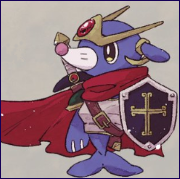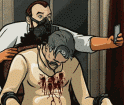|
I mean, it sounds like right now it's dice rolling + workers which is dice manipulation and a lot of euro players don't really have an issue with that. Do you want to have hidden information? (putting up a screen during combat to hide how many bees each team puts forth) to let attackers and defenders determine how many they want throw out in secret and then reveal? How devastating for the defending player is it to lose?
|
|
|
|

|
| # ? May 15, 2024 16:11 |
|
I may keep the dice rolling, just looking at alternatives since I hadn't really thought of it before. I would like to avoid a screen just because I don't want the extra components, but players bidding with their workers and/or resources in secret might work ok. Right now, if the defending player loses they lose half of one of their resources rounded down, so it ranges from minor to devastating.
|
|
|
|
nesbit37 posted:I may keep the dice rolling, just looking at alternatives since I hadn't really thought of it before. What's at stake for the attacker? Do they get anything from an attack or is it just making someone lose something? If the defense wins do they still lose workers or is it an all-or-nothing affair? It sounds like the most efficient move in any situation is to attack with one guy and hope you roll a 6. You should think about what pvp does to serve the game. If losing half your stuff is at stake then the players want to have as few resources as possible so they have little to lose making pvp only a check against someone who is hoarding.
|
|
|
|
To expand on that, combat should probably give the attackers something just so games don't turn into that annoying metagame of "someone needs to attack Player A because otherwise they're going to win, but doing it just wastes my turn so I'm going to pass the buck and tell someone else to do it". That will still happen sometimes but the less it does, the better, for me at least.
|
|
|
|
al-azad posted:What's at stake for the attacker? Do they get anything from an attack or is it just making someone lose something? If the defense wins do they still lose workers or is it an all-or-nothing affair? It sounds like the most efficient move in any situation is to attack with one guy and hope you roll a 6. If the attacker succeeds, they get 2VP, the resource the defender loses, and 1 disease (this is bad). Whether they win or lose, the workers they use in the attack action are spent and can do nothing else that round. PVP is in the game for a few reasons. The first is simply logical. If players can attack the "enemy" AI run hives why can't they attack player hives? One of the main reasons is to provide an additional strategy that is viable to win the game with, and finally to make sure resource hoarding as a strategy isn't something so good you just ignore all other strategies. I don't think the game has to have PVP, but its thematic and also I don't at the moment see a better way to address those three reasons as to why its in the game to begin with.
|
|
|
|
nesbit37 posted:If the attacker succeeds, they get 2VP, the resource the defender loses, and 1 disease (this is bad). Whether they win or lose, the workers they use in the attack action are spent and can do nothing else that round. Well, knowing nothing about how your game plays I can only say from a distance that with a flat D6 I would make throwaway attacks against people for cheap VP. There's nothing more frustrating than winning by what feels like a lucky roll. Since your game does reward VP for winning fights I'll point you to Kemet which is basically the poster child for Good Euro Combat. Everyone has the same set of cards rated in attack, defense, and damage. If the attacker wins they get a VP if at least one dude survived the fight. But the damage value is what's actually used to remove units so you can end up in unique scenarios where the defender intentionally throws the fight to kill all of their opponent's units, denying them a VP anyway. Or the attacker sends a cheap suicide unit in to soften up an area before bringing the main forces in. If you don't want to add extra components, then approach the dice not as a modifier but as a limiter. Attacker rolls a d6 and that's how many "hits" they do but it can't exceed the number of actual attackers (so 1 guy can only generate 1 hit at most). Defense can sacrifice workers to block hits and unless you block them all the attacker wins.
|
|
|
|
al-azad posted:
This is an awesome idea, I think I will give it a try. I just need to figure out two things with it. 1) figure out the right die to use (players can have up to 20 workers so they could, though not likely, attack with them all) and 2) figure out a way to make this work with PVE. Right now I am thinking attack with a number of workers and roll a die, if the two numbers add up to the strength of the PVE opponent or greater you win, if you are under the number you can sacrifice the difference in workers to win.
|
|
|
|
I have to say that for me making a game about social insects PvP feels weird. Love the theme though.
|
|
|
|
|
Yeah, most people don't think of bees being aggressive with other bugs but they do it all the time. If things get tight and the flowers aren't putting out, like usually happens in the summer months, they won't hesitate to rob honey from their neighbor bees.
|
|
|
|
nesbit37 posted:If the attacker succeeds, they get 2VP, the resource the defender loses, and 1 disease (this is bad). Whether they win or lose, the workers they use in the attack action are spent and can do nothing else that round. If you're going to have player combat work as an optional sprinkle, I think you need to reconsider the player motivations involved. Are you intending to make a political game where players want to band together against the leader - and so players try to "fly under the radar" and not get attacked? Do you want a game where a player who's not doing well also becomes an easy source of VP and resources? It's really hard to balance self-directed "prize fighting" in such a way that people want to do it sometimes but not all the time, such that it impacts the game but doesn't overshadow other play elements, and such that it doesn't snowball victories and defeats. I'd suggest maybe: 1. VP for successfully attacking another player once, but diminishing or zero returns for attacking that player again. 2. Set up the mechanics such that nobody ever wants a fight, but that sometimes players are forced into fighting by timed events
|
|
|
|
jmzero posted:
This one is kind of in already. You can only attack the same player once per round. Additionally, any workers used in that action can't be used to defend your hive, so attacking potentially opens you up to attack. Timing is very important. Also, you only get the VP if your attack is successful. I'll have to redefine what success is as I try the above method. I am tempted to make a success anytime the attacker gets away with at least 1 resource, but it might be better to make it, say, they get the VP if they bring back at least half as many resources as workers they used in the attack. jmzero posted:2. Set up the mechanics such that nobody ever wants a fight, but that sometimes players are forced into fighting by timed events The timing thing is also sort of in there. Resources are very plentiful in the spring section of the game, so there really is no good reason to fight there as long as it isn't worth the risk. The summer portion of the game, however, resources are scarce and they may have to fight just to feed their workers. The fall section is intended to be more of a section where no option is great but all could potentially work. I'm not sure if this fits in exactly with what you are suggesting though.
|
|
|
|
Here are the combat rules re-written. It looks long but that's because its really 4 sets of rules for 4 different combat scenarios. It's a little more complex than the old system but at least on paper I like it better. Will have to see how it goes in playtesting.code:nesbit37 fucked around with this message at 21:29 on Dec 15, 2017 |
|
|
|
I've been thinking of this mechanic for hidden movement. The game I'm going to use it for is centered around one player playing a slasher-movie villain with the rest of the players playing the teenaged party-goers that the villain has decided to mess with. I want this to be somewhat close to how those movies portrayed the villain as a slow-moving, large character who somehow managed to keep up with and surprise the other characters, so I came up with a hidden movement system for the villain character to use to try and emulate that. The way I've thought of handling this is that the villain gets a special movement track separate from the rest of the players. Instead of moving their meeple/token on the game board, the villain player uses the track to represent how many spaces they are moving, up to a maximum of eight spaces. The villain is revealed (and the meeple placed back on the game board) when they take any action other than moving, the players use a rare item, or the villain reaches the end of the track. Is this prone to abuse? In my head, the other players know where the villain was last and can then use that to judge whether or not the villain is cheating, but this might be a little too easy to cheat. As an aside, this was somewhat based off of Fury of Dracula, but I really hate that Dracula has to shuffle through all these cards when he moves. It feels really clunky to me, and slows the game down a lot, especially if the player playing Dracula is new.
|
|
|
|
imo worrying "will people cheat" is not a good thing to concern yourself with when designing a game. There are lots and lots of games with hidden info that it is incredibly easy and almost undetectable to cheat in; the answer to 'how easy is it to cheat' is 'don't play with lovely people'
|
|
|
|
You're right, I'm just too far in my head thinking of things that can possibly go wrong. It's the first idea I've had for a hidden movement mechanic and, because I'm an anxious person, the first thoughts that came to mind were things I probably shouldn't worry about. Do you have any thoughts on the mechanic? I'd love for some feedback before I start working on my next prototype.
|
|
|
|
I think the first question that needs to be asked is "does it matter if the slasher bother keeping track of an actual position turn by turn"? You could roll with it and just say that whenever the slasher is revealed he gets to place himself within X moves of his last known location, where X is however many moves he's had since going into hiding. Obviously if you were going for a very deduction-heavy game this would be a nonstarter--I'm assuming that unlike Fury of Dracula the players are not trying to hunt down the slasher, so having a defined location is not necessarily important. But if the victims are just trying to avoid the slasher long enough to accomplish other goals it could be a fun twist that would help simplify things while being very thematic.
|
|
|
|
Every hidden movement game I've played has a built in system for tracking movement after the fact. Once the game is finished you can work backwards from end to beginning. So while I agree you shouldn't worry about cheating, I think it is important that a hidden movement system keep a player honest. If you have a system like Straight White Shark mentioned then it's not actually hidden movement.
|
|
|
|
Chip McFuck posted:You're right, I'm just too far in my head thinking of things that can possibly go wrong. It's the first idea I've had for a hidden movement mechanic and, because I'm an anxious person, the first thoughts that came to mind were things I probably shouldn't worry about. I don't since I have never played games with hidden movement before so I have a hard time visualizing it! Sorry 
|
|
|
|
I like the idea of a "horror movie" 1vAll game with hidden movement... well... now I have sort of a game idea: I'm imagining kind of a Tragedy Looper style "Overlord knows the rules, players figure them out" game that allows for the recreation of a variety of horror movie scenarios. The Horror player gets a set of rules that control how he moves (he gets a "secret tunnels" version of the map that tells him he can go straight from the docks to the garage, etc), how he kills (maybe he can only kill meeples that are alone, or maybe has different options that he can only trigger in certain rooms/times/etc.. maybe he has a rule that says "if you kill a dude and someone else was in the room you have to read this text"), and what his motivation/win-condition is. The players "wrangle" a bunch of partier meeples, with specific actions also available depending on the scenario. They can always just move a dude - but maybe they can also "start the music" or something to bring all the meeples back together in the main room or whatever. Maybe certain meeples have access to certain actions (the jock can attack the monster if he's visible, this other person can explore or read the book or whatever). The players generally have victory conditions that the monster needs to work to avoid - like calling the cops or running away or something - or they might win just by having anyone survive 9 turns or whatever. And the monster might have actions available at different times - like making some guy and girl meeples sneak off together at an inopportune time that he can trigger based on some rules/timing. In practice, it plays out with the players hemorrhaging random people while trying to figure out how the monster works, but they also have some characters with sort of "plot armor" such that they can't be killed until a certain number of other people are killed or only in certain ways or something. Rather than having a known set of possible rules (as in Tragedy Looper), I think you have the Horror player be forced to read "clue texts" as he acts (and have a straightforward enough theme) that give players thematic ways to figure out how the monster works and how they can hope to win. The last trick, I think, is how you manage all this information for a bunch of scenarios (because the scenarios wouldn't have great replayability) without having a million cards and such. I think maybe the answer is put everything in books. In the player book (which you make "coil bound" so it lays flat), each pair of pages has one page that's a playable map (ie. you put your dudes and/or status markers on the page, so you don't need any separate boards or scenario specific markers), and on the opposite page is the scenario rules the player gets to know about and their characters special abilities. In the monster book, you have annotation for the map, some text that you read out loud, your special scenario abilities, etc.. Not sure about whether you need an explicit "looping" setup (which seems hard to balance for this) or maybe it's just expected that the monster and players normally "survive" so they see most of the fun content - and then a winner is decided either by a final fight (which is biased based on how the game went) or just by score. Maybe in this game the players got a bad score because while obviously the main character won, all their friends died, and they had to spend a VP to give the main character a "surprise I wasn't actually killed by that" return half way through. I also think maybe you want some way to "leak" hidden information on a per-scenario basis. Like, maybe the Horror might have to reveal their current location, or the status of some "trap" or something using some kind of coded "Oracle" card that's publically viewable (maybe the cards have Horror-y symbols on them that hint at what they mean, again on a per-scenario basis, with the rules spelled out in the secret scenario rules). I like this as an information leak/player-puzzle mechanism, but also as a way for the Horror player to remember where they are and/or what they have going on, but without requiring a screen or something (and it's simple for them, because it just says "when you move to this location, remove your Horror figure from the map and display card "Campfire"). Anyway, I think it'd be a bunch of work and require a lot of creativity to come up with different scenarios (and the scenarios do need to make sense and have a lot of variety for the game to work... oooh, you could even have some "sequel" chains where some rules are re-used, but with some new twist because this time it's the original killer's son or whatever). ...but I think it'd be a ton of fun. jmzero fucked around with this message at 21:37 on Dec 28, 2017 |
|
|
|
So kinda betrayal esque but without the lovely exploration setup phase and actually balanced thought out scenarios? Yeah I could see that working.
|
|
|
|
|
There is a really old space fleet combat game I can't remember the name of that did this with fleet movement. You sent a fleet into hyperspace and moved it to a numbered tracker on the side of the board and moved it forward each turn. When they decided to drop from hyperspace, you just put the fleet back onto the main board a number of spaces from it's original position equal to the number it reached on the tracker. It's been done before and it works, even if that game was stale and had no meat to it.
|
|
|
|
Try to make it hard to accidentally cheat.
|
|
|
|
https://www.newscientist.com/article/dn9424-big-brother-eyes-make-us-act-more-honestly/ Basically print a pair of eyes on top of the hidden-info player's reference/character sheet.
|
|
|
|
I remember an older edition of Unknown Armies had an Avatar based on Jason type horror movie tropes that moved slowly, but when out of sight moved incredibly quickly, and I think the Friday the 13th videogame does something similar where Jason can teleport, to a random point in a specific area? I could see a somewhat interesting set up where whenever players can't draw line of sight to the Killer, the Killer can move to any point the players can't draw line of sight too. Though that doesn't quite capture the ability to open a door and, surprise, the Killer is on the other side. I could see a setup where when in sight of the Killer you take Stress damage that messes with your rolls perhaps, but while out of sight of the Killer the Killer gains a resource they can spend on movement, popping up in unexplored rooms, setting traps, etc. Sounds like a neat, hugely ambitious, idea. Sandwich Anarchist posted:There is a really old space fleet combat game I can't remember the name of that did this with fleet movement. You sent a fleet into hyperspace and moved it to a numbered tracker on the side of the board and moved it forward each turn. When they decided to drop from hyperspace, you just put the fleet back onto the main board a number of spaces from it's original position equal to the number it reached on the tracker. It's been done before and it works, even if that game was stale and had no meat to it. This seems like a really simple way to do it. If you wanted to add an element of surprise to it make it so instead of being a strict 1:1 set up its some random variable per turn spent in "hyperspace"
|
|
|
|
Anniversary posted:I could see a somewhat interesting set up where whenever players can't draw line of sight to the Killer, the Killer can move to any point the players can't draw line of sight too. This is sort of how Shadows in the Woods (Waldschattenspiel) works, but with inverse numbers, ie. Many light sources following set paths and one pawn teleporting in the shadows.
|
|
|
|
How do you guys like to deal with variance when playing with low numbers of dice? I'm designing a game where players only roll around 4-6 dice at most. The dice are custom, with one symbol per side. Players start with generic boring dice, but swap them out with more specialized dice as the game goes on. The dice the players swap in are specialized - attack dice, support dice, etc. The idea being everyone starts the same, but then can specialize as the game goes on. However, I've ran into a problem where there's a lot of variation and dice aren't super reliable, due to the low number of dice and a single symbol per side. Keeping the dice simple makes it very easy to tell what each type of die does with a glance to a reference card. Possible solutions I've thought of: 1) More dice per player. More dice means less variance overall. However, this comes with the problem that I'll need to produce more dice, raising production costs - and since there's already lots of custom dice, I'd rather go with another option, if available. 2) More symbols per side on each die. More symbols means less variance per die, and it gives me a bit more flexibility with designing the dice. However, this muddies the readability of the dice, making it harder to tell at a glance what each one does, adding to the mental burden of the game. I'm trying very hard to cut down the mental burden as much as humanly possible. 3) Give players re-rolls. I'm thinking each player can re-roll one die per turn. After some initial playtesting this feels pretty good - dice remain easily readable and don't require tons of components. However, it is still extra mental burden, as players need to remember the rule of being able to re-roll a die each turn. I could possibly give players tokens that they flip to re-roll (adding a bit of resource management, which is already present elsewhere in the game) but then that's more components, which means more production costs. However, there are other tokens in the game, so maybe adding a few more is financially trivial. Can anyone who knows more about production costs please weigh in on my concerns? Or if anyone has any other ideas for means to reduce variance without increasing complexity / number of components.
|
|
|
|
jmzero posted:I like the idea of a "horror movie" 1vAll game with hidden movement... well... now I have sort of a game idea: 2-5 player game. 1 player is the horror/antagonist player, and all others are protagonist players that collectively control all the "survivor/victim" meeples on the map. A starting number of meeples in 4 different colors are placed on the spiral-bound map, and a certain amount of them are placed aside as a general supply that can possibly supplement them (different for each scenario). A victory condition for the horror player in every scenario will be to eliminate all meeples available in the general supply, but they can also have scenario-specific victory conditions. On each protagonist player's turn, they choose a location on the map with 1+ meeples and either move and/or perform an action with the meeples from that location in either order. The base meeple actions available will be different each scenario as shown in the spiral-bound book, but they have a condition to perform based on what meeples are together in that location. (1 red meeple and 2 blue meeples in the same location can perform action X, etc.) What kinds of people the different color meeples represent can also be different each scenario. (In the slasher scenario, red meeples are jocks. In the zombie scenario, they are national guard soldiers, etc.) Moving meeples is similar to Five Tribes: the player picks up any number of meeples from the same location and can move to any adjacent/connected locations as long as they place at least 1 meeple in every location they move to. Some locations have scenario-specific actions printed on the map that can be performed there by protagonist players. Nothing is spent for most of these basic meeple actions provided to the protagonists by the scenario. It's just the dangerous puzzle of trying to get the right meeples to the right places while not letting them get killed by the horror, and obviously the better/bigger actions will require larger collections of meeples. Meeples can also be laid down for different mechanics in each scenario. (Imagine a Freddy Kruger/nightmare world scenario where one page of the map is the waking world and the other is the dream world copy of it, with a horror that gets stronger the more meeples are sleeping, but meeples have to sleep in order to directly confront the horror in the dream world. [Although there could also be another way to win in the waking world to discover]. Or a body-harvester scenario where killed meeples remain on the map and can be collected by the horror to grow stronger. Etc.) To help the quarterbacking co-op issue, each player could also have a small unique powerset either on a little player board or in a hand of cards, maybe based on some virtue or positive force helping the meeples and each using a unique resource. (Something like bravery, compassion, discipline, wisdom, or something.) Maybe these actions can be done at any time as an instant for a kind of divine intervention feel. The horror player's mechanics could be quite different in each scenario, keeping the protagonists on their toes trying to figure out what is and isn't possible in each scenario. The horror player will get their book with a 2 page spread for each scenario, including a miniature map, and many of their abilities can revolve around spending a generic "threat/danger" token that they generate/gain in different ways each scenario (staying unseen by protagonists, scaring protagonists, keeping them in certain locations, etc.). However there's tons of room to iterate different mechanics they can use to move around (hidden or not) and kill off the meeples. A Slasher scenario could spend threat tokens to do that "teleport" movement when not seen up to that many locations away. While a Deadly Virus scenario could use a small pencil and pad to let the horror player track what meeples have made contact with the infected meeple for how many rounds and spend threat based on that to make them sick (laid down) and eventually die if they aren't cured. On/Off light tokens in each location in a scenario could establish the power base of a shadow monster, strengthened by the number of adjacent locations without lights on, and allow them to spend threat to extinguish lights. Hell, you could throw the players a curveball in scale with a kaiju scenario based around players either trying to evacuate the city or take down the monster (both possible victories, up to the players to decide which to pursue.) It would definitely still be a really big project, especially to balance, but I think a simple base system like this that you can iterate on is a good foundation to make it a doable project. If production could allow for it, it would be great (and much easier for the horror player) if the horror player's special components for each scenario were in a different little tuckbox in the game box, ensuring the protagonist players don't accidentally catch sight of what they may be facing, and new components are taken out as they are used for maximum reveal/surprise. The main goal of the experience for the protagonists, I think, would not be to rely on the sort of narrative crumbs read out to them by the horror player as you suggested (although this may still be required to actually connect some dots), but for them to use the sudden and deadly in-game actions of the horror player and the scenario's map, meeple character archetypes, and meeple actions to figure out what horror subgenre movie they are in, and to try to use those genre rules to find and achieve the victory condition. And of course, to keep things interesting, there would have to be some curveballs and red herrings thrown in so the win condition isn't too obvious for the bigger horror nerds. This is definitely making me want to set aside my countless other half-finished designs/prototypes and figure this one out. JMBosch fucked around with this message at 09:17 on Jan 2, 2018 |
|
|
|
There is a board game called Last Friday that's 1vA. It's similar to other hidden movement games like Whitechapel and Fury of Dracula but the objectives switch over the course of four acts representing a horror movie design where the killer hunts the teenagers then the teenagers hunt the killer. It's something to look at if you want to build from the idea. My million dollar horror idea would basically be Dungeon Petz except it's Cabin in the Woods and I'm breeding horror monsters.
|
|
|
|
al-azad posted:There is a board game called Last Friday that's 1vA. It's similar to other hidden movement games like Whitechapel and Fury of Dracula but the objectives switch over the course of four acts representing a horror movie design where the killer hunts the teenagers then the teenagers hunt the killer. It's something to look at if you want to build from the idea. I own Last Friday and it is very good. The best thing about its hidden movement mechanic is that the killer reveals his position every turns AS OF a couple turns ago, so you sort of know where he is, but are never quite sure. I just saw him, where did he go?!
|
|
|
|
JMBosch posted:I've been looking for a system for a horror movie based game for a while now, and this really hit the spot I was looking for.... Moving meeples is similar to Five Tribes: the player picks up any number of meeples from the same location and can move to any adjacent/connected locations as long as they place at least 1 meeple in every location they move to. I like a bunch of your ideas; particularly I think you're on the right track in terms of base mechanics. The movement system you describe seems like an amazingly great fit because it kind of makes "togetherness" a resource that you spend to get around the board - and that makes perfect sense in a game where separation is such a natural risk. I think it'd provide plenty of grist for interesting decisions in game, and I think it also gives a lot of design space to work with. Some recurring elements (like the lights you mention) make a lot of sense too, and give you sort of knobs players need in order to experiment and interact. The other tough nut might be combat; if you can find something satisfying for that, I think it could really come together. Anywho, please post about it if you end up going further with this. VVV: All sounds good to me. jmzero fucked around with this message at 21:25 on Jan 2, 2018 |
|
|
|
jmzero posted:I like a bunch of your ideas; particularly I think you're on the right track in terms of base mechanics. The movement system you describe seems like an amazingly great fit because it kind of makes "togetherness" a resource that you spend to get around the board jmzero posted:The other tough nut might be combat; if you can find something satisfying for that, I think it could really come together. jmzero posted:Anywho, please post about it if you end up going further with this. I currently have very loose thematic ideas for around 18 scenarios, so if anyone wants to throw more ideas out for mechanics or themes that could fit these scenarios well, or can open up ideas for new scenarios, I'd appreciate the contribution. Currently, I'm looking at:
JMBosch fucked around with this message at 19:30 on Jan 2, 2018 |
|
|
|
So a couple weeks ago, I had this idea to make a game where the board is a two page comic book spread and players are using artist meeples to 'draw' the tiles, which ties up the artists for a certain number of turns while the panel is being complete, and in the mean time other players can outbid the player who started the panel timer by placing x+1 meeples on the panel. I was toying around with some ways to go from there, and I thought it might make sense to have a market row similar to century spice road that lets you pick up cards that give more meeples or trade them for meeples of different colors, and you can spend meeples you have to pick up cards further down the row. The twist on the idea would be that the number of meeples of each color that remain in the general pool at the end of the game impact how the game scores. (for example, let's say there are 10 yellow meeples and yellow comic panels are worth 1 point per meeple. You have 4 yellow panels, so you get 40 points). I'm just mostly curious if the game sounds interesting to people.
|
|
|
|
I got my first professionally printed prototype of my game this week! Going to film a sizzle reel and Iíve got a vendor who is going to shop it around at the New York Toy Expo. Hopefully Iíll get some more bites from publishers now that Iíve got art purchased.
|
|
|
|
Balon posted:I got my first professionally printed prototype of my game this week! Going to film a sizzle reel and Iíve got a vendor who is going to shop it around at the New York Toy Expo. That is so awesome!
|
|
|
|
I ordered a prototype printing of my neuroshima hex fan army  I'm excited to actually have a physical version to test out. Surely I'll need to make some balance changes at some point but for the time being it'll be nice to have something physical to work with. I'm excited to actually have a physical version to test out. Surely I'll need to make some balance changes at some point but for the time being it'll be nice to have something physical to work with.
|
|
|
|
I don't play or like a lot of deckbuilders so I wrote one to see if I could change my mind. Tower is a two-player trick-taking deckbuilder where each player is trying to lure more tenants into a tower that's being built. Ideally players will balance tower needs with attempts to get new cards or dump unneeded ones on the other guy. I might be a bit premature in talking about it since while I have a first handmade copy ready to play I haven't actually transformed the rules from my sketches and notes to, like, instructions. I guess part of this post is making it real, such that I can be motivated to finish writing instructions and get it submitted to a bgg contest. I'm mentioning it here first because this is so much less formal. Also since I barely know anything about deckbuilders I don't know if this has been done before such that any attempt is going to have to acknowledge it.
|
|
|
|
Casnorf posted:I don't play or like a lot of deckbuilders so I wrote one to see if I could change my mind. Tower is a two-player trick-taking deckbuilder where each player is trying to lure more tenants into a tower that's being built. Ideally players will balance tower needs with attempts to get new cards or dump unneeded ones on the other guy. I might be a bit premature in talking about it since while I have a first handmade copy ready to play I haven't actually transformed the rules from my sketches and notes to, like, instructions. I guess part of this post is making it real, such that I can be motivated to finish writing instructions and get it submitted to a bgg contest. I'm mentioning it here first because this is so much less formal. Also since I barely know anything about deckbuilders I don't know if this has been done before such that any attempt is going to have to acknowledge it.
|
|
|
|
Idea I need to develop more in the future: Gerrymandering The Board Game. 2-player abstract-ish game on a 10x10 grid map with blue and red pieces. Public cards are drawn from a deck which contain moves and events. If a player chooses the move, their opponent gets the event or a limited move (yeah, I'm ripping off COIN's design but it works so well). The number of moves lets you place matchsticks down to close off grids thus creating districts. You can also move already placed matchsticks to recreate districts. Every so often there's a scoring round where majority in each district scores points for that side. The events do things like move the colored pieces (new high school or housing market collapse). Some events add neutral pieces whose votes are swayed by their neighbors. Some events give districts a certain trait that interacts with the game in unique ways like a "gentrify" event causes an exodus of blue pieces from a "poor" district. e: Winner is whoever has the most points. Tie breaker is whoever has the most votes unless you're playing in the state of Virginia in which case the tie breaker is a loving coin toss. al-azad fucked around with this message at 23:28 on Mar 5, 2018 |
|
|
|
al-azad posted:Idea I need to develop more in the future: Gerrymandering The Board Game. 2-player abstract-ish game on a 10x10 grid map with blue and red pieces. Public cards are drawn from a deck which contain moves and events. If a player chooses the move, their opponent gets the event or a limited move (yeah, I'm ripping off COIN's design but it works so well). The number of moves lets you place matchsticks down to close off grids thus creating districts. You can also move already placed matchsticks to recreate districts. Every so often there's a scoring round where majority in each district scores points for that side. The events do things like move the colored pieces (new high school or housing market collapse). Some events add neutral pieces whose votes are swayed by their neighbors. Some events give districts a certain trait that interacts with the game in unique ways like a "gentrify" event causes an exodus of blue pieces from a "poor" district. I think gerrymandering has tons of potential for games! Thereís a mobile game that I think is just straight-up called Gerrymander that could be a good jumping off point for you. Thereís tons of different ways you could take the game if you wanted - one player gerrymandering and the other converting citizens, both players doing both, citizens converting randomly, etc.
|
|
|
|

|
| # ? May 15, 2024 16:11 |
|
So after NY Toy Fair I havenít had any publishers bite just yet but a few asked for a reel to show off (which Iím working on, video editing is not my cup of tea). But I had some game store owners play demos and immediately ask to order copies as theyíre confident they can move them fast. I have enough potential orders for a small print run. What do I do now?? Run a KS to fund the first edition? Self publish?
|
|
|




























